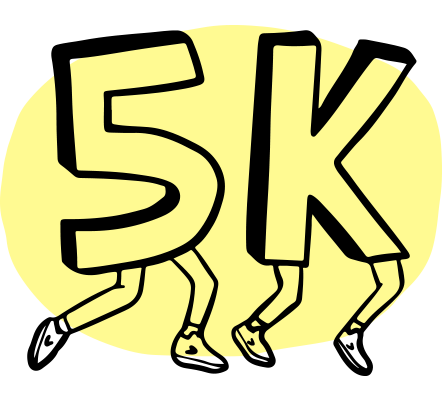Beginner training plan: How to run a 5K

Looking for a motivation boost? A new running goal? An excuse to do some A+ carb loading? Consider signing up for a 5K. Our guide walks you through how to prep for a race.
What is a 5K?
If you’re new to racing, your first question may be “how much is a 5K?”
The term is shorthand for “five kilometres,” which is just over three miles.
Most runners finish the race in 30 to 40 minutes, making it fast, fun, and far less intimidating than races that span well over an hour. It’s easy to see why this is the most popular race distance in the U.S. year after year.
How do you train for a 5K?
OK, so the race is just a couple kilometres long and enough people will be in the pack to hide any weird running faces you make. Sound good? Here’s how to get started.

Training for any race requires a holistic approach. You’ll need the right gear, good nutrition, a well-planned schedule, and accountability to keep yourself on track.
Let’s look at gear first. Make sure you have shoes, bras, and running apparel that will hold up not just for the race but for all the kilometres you’re going to put into training beforehand. Find reliably comfortable pieces and plan your race-day outfit in advance so you can take it for a test run. Don’t wear anything new on race day — the road to the finish line is paved with rashes, blisters, and chafing in unspeakable places from previously untested gear.
On that note, many runners find it helpful to experiment with their diets in the weeks leading up to a race. What you eat before a 5K is important. Use your training period to figure out how to avoid GI distress on the run and pinpoint what gives you energy to perform your best.

Don’t forget that decisions you make off the run affect your kilometres: eat a balanced diet, get enough sleep, and hydrate properly. Get in the habit of drinking water not just when you run but throughout your training.
Finally, you’re going to need a plan. More advanced runners may want a different strategy, e.g. if you’re looking to improve an old time, you’ll likely need to do some speed work. But if you’re ramping up to your first start line, here’s a schedule to get you to your mark.
Your “Couch to 5K” beginner training plan
In just about two months, you can go from “I only run when chased” to kilometre master. Seriously. Once your body gets used to running, the sport gets easier and the distance flies by.
A lesson in lingo
Here’s a guide to some of the terminology in our training plan.
GP: Goal pace. This is the speed you’re hoping to maintain for the race.
Tempo: For our purposes here, your tempo pace is one that’s challenging but sustainable. You’re out of breath but you could maintain your speed for 45 minutes.
Recovery pace: An easy jog, often reserved for active rest between faster intervals.
‘: minutes (3’ is 3 minutes)
“ : seconds (45” is 45 seconds)
Rest: Put your feet up! You need to reserve some days to let your muscles recover.
Cross-train: Do a non-running activity (swim, do yoga, lift weights, etc.)
For more runner vocab — including some of the weirdest words in the sport — check out our glossary.
Ramp up to race day
Still on the hunt for runspiration? Enlist a training buddy or join a running group — there are online groups to accommodate COVID-19 restrictions. Try out some new gear. Or check out our favourite inspiring stories.

